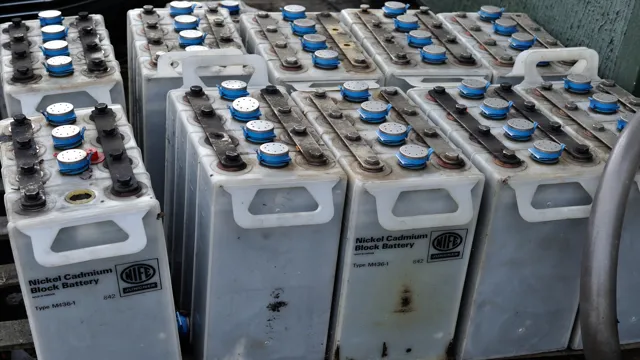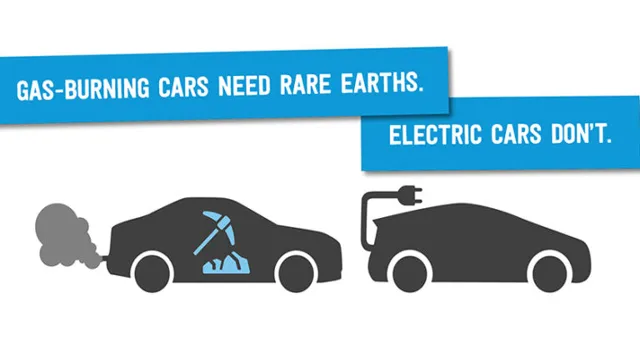Shock Corrosion: Debunking Myths Surrounding Electric Car Batteries and Gas Tanks
Electric cars have revolutionized the automotive industry, providing eco-friendly alternatives to gas-guzzling vehicles. This innovation has always raised the question of whether electric car batteries are better than gas tanks. But what sets these two technologies apart? In this blog post, we’re going to explore the differences between electric car batteries and gas tanks, their advantages and disadvantages, and how they compare against each other.
Whether you’re an eco-conscious driver or simply curious about the fundamental mechanics of electric vehicles, this blog post will provide you with everything you need to know about electric car batteries and gas tanks!
Battery Composition
One of the advantages of electric cars over traditional gas-powered vehicles is the battery composition. While gas tanks can be easily punctured, electric car batteries are much harder to damage. This is because battery packs in electric vehicles are typically encased in strong metal and have numerous safety features built into them.
In addition, the composition of the batteries themselves is less volatile and less likely to combust compared to gasoline. Thus, electric cars have a lower risk of accidental fires and explosions in case of a collision. While electric car batteries are not completely invincible, they are certainly more robust and safer than gas tanks, providing drivers with additional peace of mind on the road.
Materials Used in Electric Car Batteries
When it comes to electric vehicle technology, the battery is the heart of the system. The composition of an electric car battery is quite different from a traditional build, and usually consists of several main components such as a cathode (positive electrode), an anode (negative electrode), electrolyte, and a separator. Typically, lithium-ion batteries are used in electric cars, and the cathode is usually made from a combination of metals such as nickel, cobalt, and manganese.
The anode is most commonly made of graphite, while the electrolyte is usually a liquid or gel combination of salts and solvents. The separator is a polymer membrane that keeps the cathode and anode separate while allowing ions to pass through. As the car moves, the battery discharges or charges depending on the energy requirements of the vehicle.
The battery plays a significant role in determining the performance, cost, and range of an electric car.

Materials Used in Gas Tanks
Battery Composition When it comes to gas tanks, one of the most important materials used is the battery. Battery composition can vary depending on the type of vehicle and the desired performance. Typically, car batteries are made up of lead-acid cells that convert chemical energy into electrical energy.
These cells contain a mixture of sulfuric acid and water that reacts with lead plates to create an electrical charge. However, advancements in technology have led to the development of new types of batteries, such as lithium-ion. Lithium-ion batteries offer a higher energy density, longer lifespan, and are lighter in weight.
While they may be more expensive, they provide a more efficient and reliable power source for modern vehicles. In summary, the battery composition used in gas tanks plays a crucial role in the performance and reliability of vehicles, and advancements in technology have allowed for the development of more efficient and reliable options.
Puncture Test Results
Are electric car batteries harder to puncture than gas tanks? The answer is yes. Electric car batteries are designed to be safer and more durable than traditional gas-powered vehicles. Manufacturers use materials like aluminum and high-strength steel to make battery casings as strong as possible, and some even use additional safety measures like heat sensors and cooling systems to further prevent damage.
In fact, recent studies and tests have shown that electric car batteries are much more puncture-resistant than gas tanks. One study conducted by the National Highway Traffic Safety Administration found that electric car batteries were much less likely to rupture during an accident than gas tanks. In a separate puncture test, researchers found that it was much harder to puncture an electric car battery compared to a gas tank, and even if the battery did puncture, the risk of fire was significantly lower.
This is great news for electric car drivers, who can feel safer on the road knowing that their batteries are less likely to rupture in the event of an accident. Additionally, the increased durability of electric car batteries means that they require less maintenance and have a longer lifespan, making them more cost-effective in the long run. Overall, the safety and durability benefits of electric car batteries make them a compelling choice for environmentally-conscious drivers looking for a practical and safe mode of transportation.
Statistics on Battery Punctures
Battery punctures can be a serious issue, and it’s always important to understand the risks involved. Puncture tests are the most common way of determining how safe a battery is. When a battery is punctured, it can potentially leak dangerous chemicals or explode.
The results of these tests can give us valuable insight into how well a battery can handle different kinds of stressful situations. With many different types of batteries on the market, there are a wide variety of statistics when it comes to punctures. For example, some kinds of batteries are more likely to puncture than others.
Lithium-ion batteries are especially prone to punctures, and their relatively high energy density means that they can be even more dangerous when punctured. Fortunately, there are also many measures that can be taken to prevent punctures from happening in the first place. Proper handling and storage of batteries can go a long way towards reducing the chances of a puncture.
Additionally, many batteries now come with features designed to mitigate the risks of puncture, such as built-in safety mechanisms that prevent the battery from exploding in the event of a puncture. Overall, while punctures are always a risk when it comes to batteries, there are many steps that can be taken to mitigate these risks. By understanding the potential dangers and taking steps to reduce the likelihood of a puncture occurring, we can enjoy the many benefits that batteries bring, without putting ourselves in unnecessary danger.
Statistics on Gas Tank Punctures
Gas Tank Punctures, Puncture Test Results Gas tank punctures are a widespread problem, and they can cause all sorts of issues, from loss of fuel to threatening the environment. Luckily, researchers have been running puncture tests on gas tanks for decades to help identify underlying causes and hopefully prevent punctures from happening. The test results have shown that the most common causes of gas tank punctures are external forces such as collisions, wear and tear, corrosion, and damage from rocks or debris.
Interestingly enough, gas tank punctures can also occur due to manufacturing defects, such as misaligned components or faulty welding. No matter the cause, it’s essential to regularly check your gas tank for any signs of damage, and if you do experience a puncture, take immediate action to prevent further damage or harm.
Comparing Puncture Resistance
When it comes to selecting the right tire for your vehicle, puncture resistance is an important factor to consider. After all, nobody wants to deal with a flat tire in the middle of a road trip. To test puncture resistance, manufacturers put their tires through a series of intense tests that simulate real-world conditions.
During these tests, the tire is punctured with a sharp object and the force required to penetrate the tire’s surface is measured. The results of these tests can be helpful in determining how well a tire will hold up against road hazards. Keep in mind that different tires have varying levels of puncture resistance and it’s important to choose the tire that best fits your individual needs.
So, before you hit the road, make sure you have a tire that will keep you safe and on the go.
Safety Implications
Electric car batteries are generally safer than gas tanks when it comes to punctures and crashes. Gasoline is a highly flammable liquid that can easily ignite in case of an accident, causing a fire or even an explosion. On the other hand, electric car batteries are built with safety in mind and are designed to be more puncture-resistant than gas tanks.
Modern electric car batteries are often made with robust materials such as lithium-ion that can withstand high impact, and even if damaged, they are less likely to cause a fire. Moreover, electric cars have multiple layers of protection and safety features that prevent the battery from being punctured or damaged in the first place. The safety implications of electric car batteries are excellent, and they continue to be improved as the technology advances.
With these advancements and safety features, the risk involved with electric car batteries’ safety (even in accidents) can be mitigated compared to gas tanks.
Fire Hazards of Gasoline
Gasoline is a highly flammable substance that requires careful handling to avoid potential fire hazards. When gasoline is exposed to high temperatures or sparks, it can ignite and cause serious damage. To prevent the risk of fires, it is important to follow proper safety procedures when handling gasoline.
Store gasoline in approved containers away from any heat sources or ignition sources such as furnaces and water heaters. Never smoke around gasoline or use it near open flames. Always use caution when filling up your vehicle and make sure to clean up any spills immediately.
Fire hazards associated with gasoline can be deadly, so it is important to take the necessary precautions to prevent accidents from happening. Remember, safety should always be a top priority when working with gasoline.
Fire Hazards of Lithium-ion Batteries
Lithium-ion batteries have become increasingly popular due to their long life and rechargeability, but they also pose a significant safety risk. The most common fire hazard associated with these batteries is thermal runaway, which occurs when a battery’s temperature rises uncontrollably, leading to a chain reaction of overheating and causing the battery to ignite. This can cause serious injuries, property damage, and even death.
Many factors can cause thermal runaway, including overcharging, physical damage, and exposure to high temperatures. It’s crucial to understand the safety implications of lithium-ion batteries and take necessary precautions, such as using the correct charger, avoiding overcharging, storing batteries in a safe place, and not exposing them to extreme temperatures. By following these practices, we can enjoy the benefits of these batteries without posing a danger to ourselves and our environment.
Long-Term Cost Analysis
One of the benefits of electric cars is that they don’t have gas tanks, which means there is no risk of a leaking or exploding fuel source. Instead, electric cars are powered by batteries, which are designed to be much safer and harder to puncture. While car batteries can still be punctured in rare cases, they are typically constructed with multiple layers of protection, including a tough outer shell and reinforced internal structure.
This makes it much less likely for an electric car battery to rupture in the event of an accident or collision, compared to a traditional gas tank. Additionally, electric cars are designed with safety features that automatically shut off the battery in the case of a collision, further reducing the risk of injury or damage. Overall, electric car batteries are much safer and more reliable than gas tanks, making them a better long-term investment for drivers who prioritize safety and sustainability.
Replacing a Gas Tank vs. Battery
When it comes to replacing a gas tank versus a battery, the long-term cost analysis is essential to consider. While a new gas tank may initially seem like the more affordable choice, it is important to keep in mind the cost of refilling the tank over time. On the other hand, a battery may have a higher upfront cost, but it can ultimately save you money on fuel and maintenance expenses in the long run.
It’s like comparing a high-quality pair of shoes to a cheaper version – the initial investment may be more significant, but the durability and long-term cost-effectiveness make it a better investment overall. So when considering whether to replace a gas tank or battery, it is important to weigh both short-term and long-term costs to make the best decision for your wallet and your vehicle.
Environmental Impact of Battery Production
When considering the environmental impact of battery production, it’s crucial to factor in the long-term costs. Yes, batteries have revolutionized how we power our devices and vehicles, but they come with a heavy price tag. The production process involves the extraction and mining of resources such as lithium, cobalt, and nickel, which requires vast amounts of energy, water, and other resources.
This production process not only depletes natural resources but also contributes to greenhouse gas emissions that accelerate climate change. Additionally, battery disposal poses a significant environmental threat since they contain toxic chemicals. Thus, there’s a need for companies to transition toward sustainable battery production that promotes circularity and reduces the long-term environmental impact.
Overall, it’s essential to weigh the long-term environmental costs versus the short-term benefits of battery production.
Environmental Impact of Gasoline Production
When it comes to the environmental impact of gasoline production, a long-term cost analysis shows that we are paying a high price for our dependence on fossil fuels. Not only do the processes involved in extracting, refining, and distributing gasoline generate significant amounts of greenhouse gases, but the continued burning of these fuels is driving climate change and its associated consequences. Beyond the immediate environmental costs, there are also long-term costs associated with the depletion of finite resources like oil and gas.
As these resources become increasingly scarce, the cost of production rises, which in turn raises the cost to consumers. To truly understand the full impact of gasoline production, we must consider the short-term and long-term costs, both financial and environmental. Making the switch to alternative, renewable sources of energy may involve higher upfront costs, but in the long run, it is likely to be a much more cost-effective and sustainable solution.
Conclusion
In conclusion, while electric car batteries are not completely impervious to punctures, their construction and placement make them significantly more robust against damage compared to traditional gas tanks. With advancements in technology and the increasing use of alternative materials, it’s safe to say that the future of transportation is indeed electric- and puncture-resistant!”
FAQs
What are the risks of puncturing an electric car battery compared to a gas tank?
Electric car batteries are generally considered to be safer in the event of puncture than gas tanks. Unlike gasoline, the electrolyte in electric car batteries is non-flammable and does not release harmful gases when exposed to air. However, puncturing an electric car battery can still cause damage to the cell, which could result in degraded performance or a loss of capacity.
Can electric car batteries explode if punctured?
While electric car batteries are generally considered to be safer than gas tanks in the event of puncture, there is still a risk of thermal runaway if the battery is compromised. In rare cases, puncturing an electric car battery could result in a fire or explosion. However, modern electric car battery packs are engineered with safety systems and fail-safes that prevent thermal runaway and ensure the battery remains stable even in extreme conditions.
How do electric car manufacturers prevent the risk of battery puncture?
Electric car manufacturers take several steps to minimize the risk of battery puncture, including the use of high-strength materials for battery casings, advanced sensors that monitor battery health and temperature, and fail-safe systems that can isolate damaged cells to prevent thermal runaway. Additionally, electric car batteries are tested extensively to ensure they can withstand a wide range of impacts and environmental conditions.
Are electric car batteries more expensive to repair in the event of puncture?
Repair costs for punctured electric car batteries can vary depending on the extent of the damage and the type of repair required. In some cases, minor punctures can be repaired without replacing the entire battery pack, which can be less expensive than repairing a gas tank. However, more severe damage can require the replacement of one or more battery modules, which can be costly. Overall, the cost of repairing a punctured electric car battery will depend on a variety of factors and should be evaluated on a case-by-case basis.






